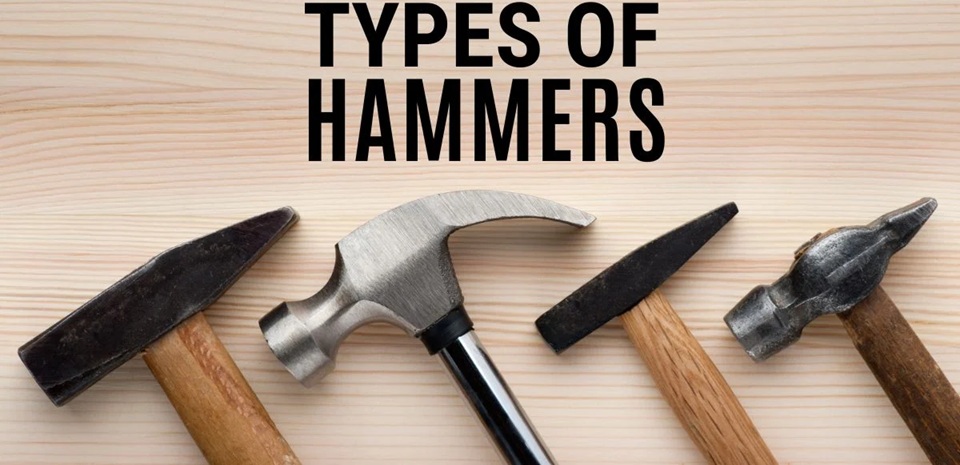
HAMMER – A Traditional Yet Sophisticated Tool, Ranging from Basic Applications to Rigorous Quality Control Procedures in Modern Industrial Production
I. Introduction and Definition
A hammer is an essential handheld tool used to transmit an impulse force through directed impacts. Its fundamental principle is to convert mechanical energy—from either human input or machinery—into the target material to accomplish tasks such as nail driving, demolition, or metal forming. Although simple in appearance, optimizing every detail—from the selection of materials, mass, and balance to the design of the handle—is critical to ensuring work efficiency, minimizing user injury, and prolonging the tool’s service life.
II. Operating Principle
A hammer operates based on the mechanical principles of momentum and collision energy. When the user raises the hammer to a certain height, potential energy (PE) is stored. Upon release, this energy is transformed into kinetic energy (KE) and transmitted through the hammer head when it strikes the target surface. This process generates the impulse force necessary for tasks such as nail driving, fracturing, forging, or bending materials.
In addition, some modern hammers are equipped with shock reduction systems and robust, vibration-resistant handle designs. These enhancements optimize energy transfer, minimize vibration, and reduce operator fatigue—features that are especially critical in industrial applications where efficiency and safety are paramount.
III. Classification of Hammers
Hammers come in various shapes and sizes and are classified according to their intended use and design features:
-
Claw Hammer
-
Characteristics: The hammer head features two sides—a flat face for driving nails and a curved (claw) end for nail extraction.
-
Applications: Commonly used in construction, carpentry, interior work, and light repairs.
-
Advantages/Disadvantages: Simple and convenient in design, but suitable only for lighter tasks that do not require high impact forces.
-
-
Sledgehammer
-
Characteristics: A large head with substantial mass and a long handle, delivering powerful impact with each strike.
-
Applications: Utilized for demolition, breaking concrete, dismantling heavy steel structures, and other tasks that demand high force.
-
Advantages/Disadvantages: Provides tremendous impact force but requires the operator to have sufficient strength and proper technique to avoid injury.
-
-
Ball-Peen Hammer
-
Characteristics: Features one flat face and one rounded (peen) face, specifically designed for forging and bending metal.
-
Applications: Widely used in mechanical work, welding, and metal fabrication for shaping and fine-tuning metal components.
-
Advantages/Disadvantages: The rounded peen helps distribute impact force evenly; however, it demands careful maintenance to preserve the head’s precision and shape over time.
-
-
Forming Hammer
-
Characteristics: Designed with distinct die faces to create specific shapes in metal or ceramics.
-
Applications: Employed in forming, casting, and customized fabrication processes, typically in precision mechanics and specialized tool manufacturing.
-
-
Vibration-Damped Hammer
-
Characteristics: Integrates vibration-absorbing materials such as rubber, polymers, or modular assemblies to reduce transmitted vibrations.
-
Applications: Used in continuous hammering operations, especially in construction and manufacturing environments where workplace safety is a priority.
-
IV. Structure and Technical Components
A hammer is manufactured to technical standards and comprises the following main components:
-
Hammer Head: – Made from high-quality alloy steel, processed via forging, heat treatment, and surface finishing to ensure hardness, durability, and wear resistance. – Its design is tailored to the specific type of hammer to optimize the distribution of impact forces.
-
Handle: – Typically constructed from hardwood, composite materials, or high-strength steel. – The design focuses on weight balance, shock absorption during impacts, and ensuring user comfort and safety. – Some modern models incorporate rubber coatings or non-slip materials for improved vibration dampening.
-
Joint Assembly: – The interface between the hammer head and the handle must be securely bonded—using techniques such as welding, pressing, or interference fitting—to ensure efficient transfer of force from the user to the hammer head.
V. Manufacturing Process and Quality Control
-
Manufacturing Process
-
Machining and Forging: – The hammer head is typically formed through forging, heat treatment, and stamping to achieve the desired hardness and shape. – The handle is milled and processed using CNC technology to ensure precise dimensions and accuracy.
-
Surface Treatment: – Metal components are treated with anti-corrosion plating, powder coating, or protective finishes to enhance durability. – Handles may be coated with rubber or composite materials to further increase safety and comfort.
-
-
Quality Inspection
-
Mechanical Testing: – Evaluates the impact durability, load-bearing capacity, and hardness of the hammer head through standardized tests (in accordance with ISO, DIN, etc.). – Assesses the durability and stability of the joint between the hammer head and handle.
-
Product Inspection: – Measures the weight balance, vibration levels, and shock absorption properties of the handle using specialized instruments. – Involves visual inspections and dimensional measurements of each component to ensure compliance with technical requirements.
-
VI. Applications in Various Industries
A hammer is not merely a labor tool but also a vital component in supporting many industrial processes:
-
Construction: – Utilized for nail driving, demolition, and specialized tasks in construction, renovation, and infrastructure projects.
-
Mechanical and Metal Fabrication: – Ball-peen and forming hammers are commonly used in machine shops, welding workshops, and metal fabrication facilities.
-
Manufacturing and Assembly: – Vibration-damped hammers and other specialized models used in automated production lines help ensure efficient, safe processes and minimize manual operation errors.
-
Specialized Applications: – In shipbuilding, machinery manufacturing, and even the electronics industry, mini hammers or specialized hammers are designed to meet extremely sensitive requirements for impact force and precision.
VII. Operating Instructions and Maintenance
-
Operating Procedures
-
Operational Technique: – Using a hammer accurately requires the operator to maintain the correct position and impact angle, maximizing energy transfer without overloading the hand or back. – For precision tasks, operators must consider the weight, speed, and impact force to avoid forced strikes that could deform the tool.
-
Occupational Safety: – Always use personal protective equipment (e.g., shock-absorbing gloves and safety goggles) to prevent accidents. – Inspect the hammer prior to use to detect any early signs of wear, cracking, or damage.
-
-
Maintenance and Periodic Inspections
-
Cleaning: – Wipe down and remove dirt and grease after each use to prevent surface corrosion, thereby preserving the metal and handle integrity.
-
Storage: – Store in a protective case or in a dry area, avoiding moisture and high temperatures to maintain the tool’s technical properties.
-
Periodic Inspection: – Regularly check the joints between the hammer head and handle; if any looseness or wear is detected, replace or reinforce the assembly immediately.
-
VIII. Technological Trends and Developments
In modern industrial contexts, innovative design and advanced materials are widely implemented to optimize performance and safety:
-
High-Grade Materials – Composite Materials: – By combining advanced steel alloys with composite materials, hammers are becoming lighter, stronger, and more wear-resistant, with superior vibration dampening for the user.
-
Ergonomic Design and Shock Reduction: – Modern hammers are designed based on comprehensive mechanical and ergonomic analyses, with a strong focus on weight balance, shock absorption, and vibration resistance to enhance worker performance and minimize the risk of injury.
-
Digital Technology Integration: – Some premium models integrate impact force sensors that record data and support quality control processes, setting new benchmarks for automated production systems.
IX. Considerations When Choosing and Purchasing a Hammer
When selecting a suitable hammer, users should consider the following criteria:
-
Material Quality: – Opt for products fabricated from high-quality alloy steel with anti-corrosion surface treatments to ensure long-term durability.
-
Weight Balance and Handle Design: – Evaluate the overall weight and balance of the hammer; the handle should be manufactured from sound-insulating, non-slip materials to ensure comfort and safety.
-
Functionality and Applications: – Define the intended use (e.g., nail driving, demolition, forming) and select a specialized hammer that meets the specific technical requirements.
-
Warranty and Technical Support: – Reputable suppliers offer warranties, periodic inspections, and technical support, providing greater confidence during operation.
Conclusion
Although it is a classic tool, the hammer continues to play a pivotal role in a wide range of applications spanning construction, mechanical engineering, and industrial manufacturing. A thorough understanding of its design, operating principles, manufacturing process, and technical standards enables users to select, operate, and maintain the tool effectively—thereby enhancing productivity and ensuring a safe working environment. Moreover, with ongoing advancements in technology and the adoption of premium materials, the future of hammer products holds promising opportunities for both production and application in diverse industrial sectors.
You can purchase high-quality hammers from QTE Technologies, an international MRO supplier offering over one million products. We are proud to serve customers in more than 180 countries. Contact us anytime via our 24×7 chat support, telephone, WhatsApp, or email. Discover what our valued customers have to say about our services on our dedicated review page.
Post Author By QTE Technologies Editorial Staff (with a solid background in both technical and creative writing - accumulated 15+ years of experience).




